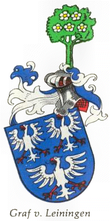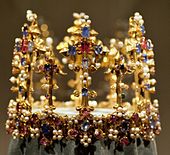Gottfried von Leiningen
Gottfried von Leiningen , also Jofrid von Leiningen , from the Palatinate dynasty of the Counts of Leiningen, was elected (unconfirmed) bishop of Speyer or archbishop of Mainz from 1396 to 1397 , then provost of Mainz.
Origin and family
He was the son of Count Emich V. von Leiningen and his second wife Margaretha von Kyburg , daughter of Eberhard II. Von Neu-Kyburg and Anastasias born. from Signau . His brother was Count Emich VI. von Leiningen , with whom he was also involved in the government of the county. In 1404 he gives together with Emich VI. the approval of a bond of the communities Groß- and Kleinbockenheim , Mühlheim and Colgenstein , 1405 both brothers approve a monastery mass in Dürkheim . The grave slab of his brother Eberhard von Leiningen , who died at a young age in 1380, was formerly in the cloister of the Worms Cathedral , today in the local Andreasstift museum .
Live and act
The Leininger received his first benefice at the Worms Cathedral monastery . As canon of Worms, he moved to the University of Paris with his court master Hugo von Landau in 1380, where he obtained the degree of Baccalaureus Artium on February 10, 1382 . In 1380 he also received a canon donation in Cologne . In 1389 "comes Godfridus de Lyningen, cappellarius et canonicus ecclesie Coloniensis" was registered at the University of Heidelberg .
Bishop election in Speyer
Leiningen was elected Bishop of Speyer on June 20, 1396 by the majority of the cathedral chapter of Speyer , but was not confirmed by the Pope, whereupon his defeated opponent, the Speyer and Worms canon Raban von Helmstatt, was raised to Bishop of Speyer in the following year has been. At the same time, the Leininger appears as provost of the St. Georgenberg monastery (Worms-Pfeddersheim) .
Elekt from Mainz
Shortly after his unconfirmed election in Speyer, Gottfried von Leiningen was elected archbishop there on November 12, 1396 by the Mainz cathedral chapter . This choice was not confirmed by the Pope either, it fell at the time of the dispute between the Luxembourg royal family and a German opposition to princes. Leiningen was a partisan of King Wenceslas and lost his office the next year to John II of Nassau (Archbishop 1397–1419) appointed by the Pope ; even King Wenceslas refused to support him. Gottfried von Leiningen initially entrenched himself in Reichenstein Castle near Bingen . After long negotiations he renounced the archbishop's chair and was instead resigned to the lucrative office of provost of Mainz .
Canon and diplomat
In 1400 the brother Emich VI advanced. von Leiningen to the court master of the German King Ruprecht I , who under the name Ruprecht III. was also Palatine Elector . This sent Gottfried on December 14th of that year as his envoy to Rome to obtain the approbation of Pope Gregory IX. to obtain the king's election. The Leininger was accompanied by Konrad von Vechta and the Mainz canon Hermann Rode.
In 1401 Gottfried von Leiningen was used again as King Ruprecht's diplomat; this time he traveled to England to settle the dowry payments for his daughter-in-law Blanca . As part of this dowry, u. a. the so-called “Bohemian Crown” or “ Palatinate Crown ” became part of the Wittelsbach family property, which is still in the treasury of the Residenzmuseum in Munich today.
Later Gottfried stayed mostly in Cologne , where his brother Emich VI. since 1405 as council of Archbishop Friedrich III. von Saar Werden participated in important decisions. Archbishop Friedrich was a relative of Emich's wife Clara von Vinstingen through his mother.
As a representative of Friedrich von Saar Werden, Gottfried von Leiningen attended the Council of Pisa , where he arrived at the end of April 1409. On May 8th it is documented at a council meeting. The church assembly closed on August 7, 1409, but Gottfried never returned to Germany. The exact date and place of death are unknown; Pisa is presumed to be the place of death and April 23, 1410 as the date of death, since April 23 is entered in the Seelbuch of the Speyer Cathedral as the day of his death.
All contemporary sources, including those hostile to him, describe him as a very learned clergyman.
literature
- Friedhelm Jürgensmeier : Jofrid (Gottfried) von Leiningen . In: Erwin Gatz (ed.): The Bishops of the Holy Roman Empire 1198 to 1448. A biographical lexicon. Berlin 2001, p. 413.
- Martin Persch : Raban (Rhaban) from Helmstätt. In: Biographisch-Bibliographisches Kirchenlexikon (BBKL). Volume 7, Bautz, Herzberg 1994, ISBN 3-88309-048-4 , Sp. 1146-1148.
Web links
Individual evidence
- ^ Anton Philipp Brück : Count Jofrid von Leiningen, a Rhenish prelate of the late Middle Ages . In Serta Moguntina , Volume 62 of the sources and treatises on Middle Rhine Church history , Society for Middle Rhine Church History , Mainz 1989, pages 48 and 52.
- ^ Website of the grave slab of brother Eberhard von Leiningen
- ^ Anton Philipp Brück: Count Jofrid von Leiningen, a Rhenish prelate of the late Middle Ages . In Serta Moguntina , Volume 62 of the sources and treatises on Middle Rhine Church history , Society for Middle Rhine Church History , Mainz 1989, pages 52 and 53.
| predecessor | Office | successor |
|---|---|---|
| Konrad II of Weinsberg |
Elector Archbishop of Mainz 1396-1397 |
Johann II of Nassau |
| personal data | |
|---|---|
| SURNAME | Leiningen, Gottfried von |
| BRIEF DESCRIPTION | Archbishop and Provost of Mainz |
| DATE OF BIRTH | before 1396 |
| DATE OF DEATH | after 1397 |

